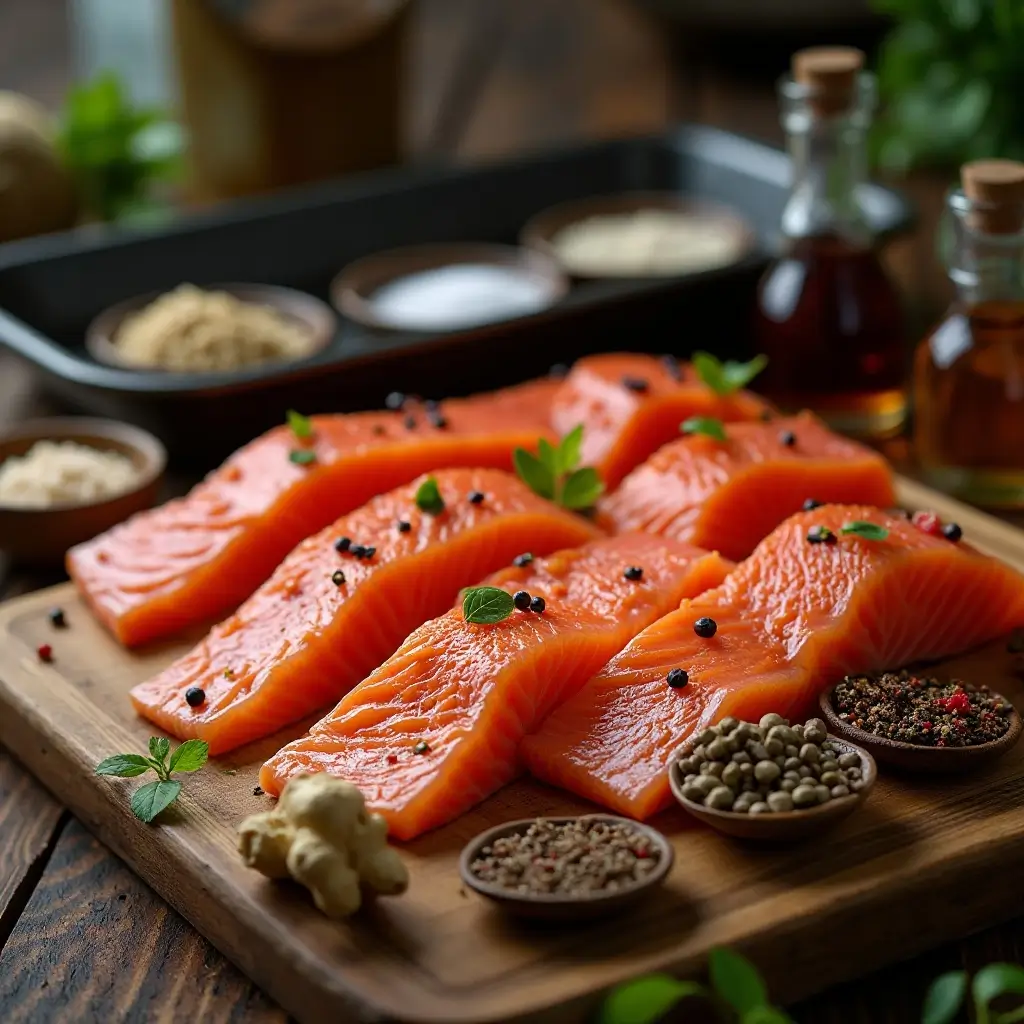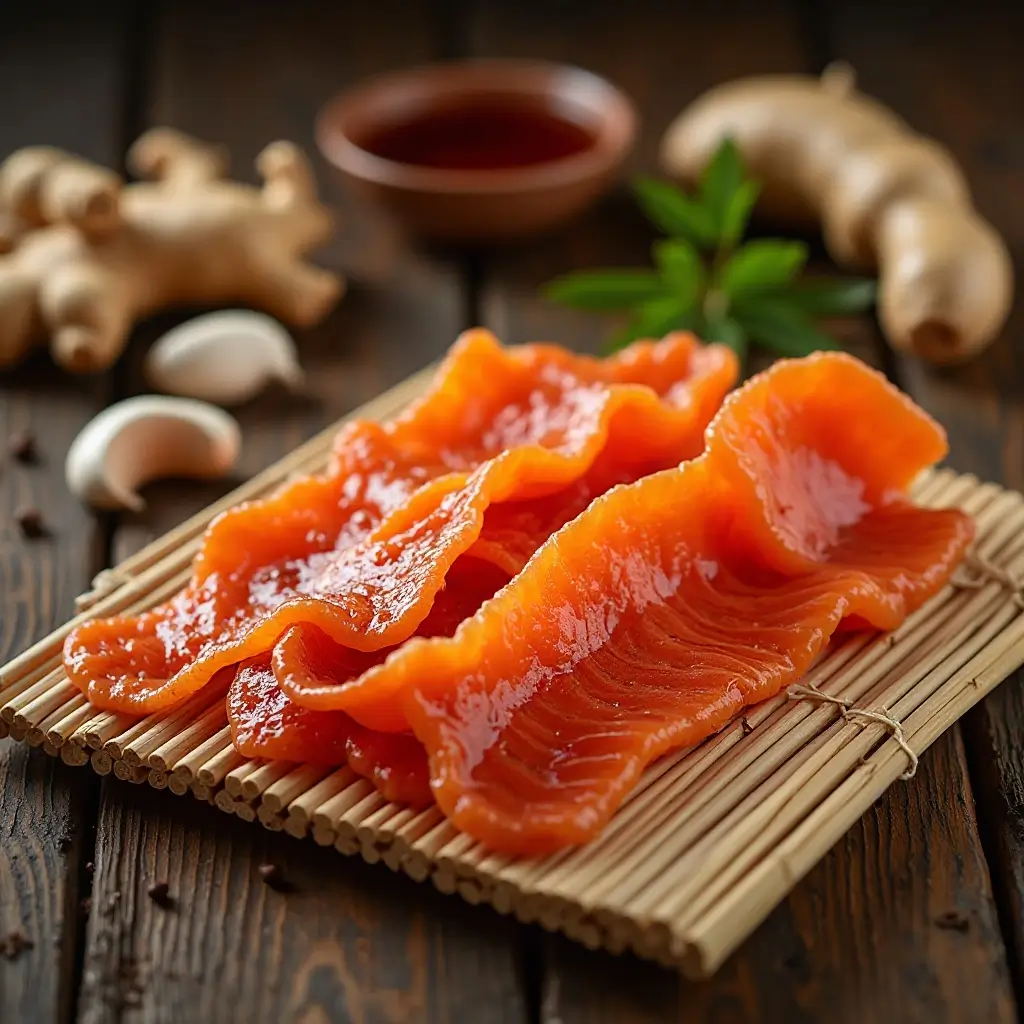5 Ingredient Salmon Jerky Recipe – Healthy Protein Snack
Craving a protein-packed snack that’s both satisfying and delicious? This salmon jerky recipe delivers incredible smoky flavors with a tender, chewy texture that’ll have you hooked from the first bite!
Did you know that salmon jerky was originally created by Pacific Northwest Native Americans as a way to preserve their abundant salmon catches? This ancient preservation method transforms fresh salmon into a nutrient-dense superfood snack that’s perfect for hiking, work, or anytime you need sustained energy.
What makes this salmon jerky special is its simplicity and quick preparation time. Unlike store-bought versions loaded with preservatives, this homemade recipe uses clean ingredients and can be customized to your taste preferences. It’s family-friendly and much more affordable than premium jerky brands.
Table of Contents
Similar to our popular beef jerky recipe that readers absolutely love, this salmon version offers a lighter, omega-3 rich alternative that’s equally addictive. Get ready to discover your new favorite healthy snack!
What is Salmon Jerky?
Ever wondered why we call it “jerky” when it’s anything but jerky movements in your mouth? This delightfully chewy salmon jerky gets its name from the Quechua word “ch’arki,” meaning dried meat.
But here’s the fun part – salmon jerky is like the ocean’s answer to traditional beef jerky, trading land for sea in the most delicious way possible. As they say, “the way to a person’s heart is through their stomach,” and this protein-packed treat certainly proves that point! Ready to dive into this sea of flavor?
Why You’ll Love This Salmon Jerky
Rich in Omega-3 Fatty Acids and Protein
This salmon jerky is a nutritional powerhouse, packed with heart-healthy omega-3 fatty acids and high-quality protein. Each bite delivers essential nutrients your body craves, making it the perfect guilt-free snack that actually nourishes you.
Cost-Saving Benefits of Homemade
Making salmon jerky at home saves you serious money compared to store-bought premium jerky that can cost $30+ per pound. With this recipe, you’ll create gourmet-quality jerky for a fraction of the price, using simple ingredients you probably already have in your pantry.
Customizable Flavor Profile
The magic lies in the marinade – a perfect blend of soy sauce, brown sugar, garlic, and spices that infuses every fiber of the salmon with incredible flavor. Unlike our teriyaki chicken jerky recipe, this version offers a more delicate, oceanic taste that’s both sophisticated and satisfying.
Transform your kitchen into a jerky-making haven and discover why homemade always beats store-bought!
How to Make Salmon Jerky
Quick Overview
This salmon jerky recipe is surprisingly simple and incredibly rewarding. The key to perfect jerky lies in proper preparation, consistent slicing, and patient dehydration.
What makes this dish easy and delicious:
- Simple 5-ingredient marinade
- No special equipment beyond a dehydrator or oven
- Tender, flaky texture with concentrated salmon flavor
- Rich, smoky taste with hints of sweetness
Total Time: 8-12 hours (including drying time) Prep Time: 30 minutes Marinating Time: 4-6 hours Drying Time: 6-8 hours
Key Ingredients for Salmon Jerky
For the Salmon:
- 2 lbs fresh salmon fillet (skin removed)
- 1 tsp sea salt
For the Marinade:
- 1/2 cup low-sodium soy sauce
- 1/4 cup brown sugar
- 2 tablespoons honey
- 3 cloves garlic, minced
- 1 tablespoon fresh ginger, grated
- 2 teaspoons liquid smoke
- 1 teaspoon black pepper
- 1 teaspoon paprika
- 1/2 teaspoon red pepper flakes (optional)
Optional Seasonings:
- 1 teaspoon sesame oil
- 1 tablespoon rice vinegar
- 1 teaspoon onion powder

Step-by-Step Instructions
Step 1: Prepare the Salmon Remove skin from salmon fillet using a sharp knife. Check for any remaining bones with tweezers. Pat the salmon completely dry with paper towels. Place in freezer for 30-45 minutes to firm up for easier slicing.
Step 2: Create the Marinade In a medium bowl, whisk together soy sauce, brown sugar, honey, minced garlic, grated ginger, liquid smoke, black pepper, paprika, and red pepper flakes. Stir until brown sugar completely dissolves.
Step 3: Slice the Salmon Remove salmon from freezer. Using a very sharp knife, slice salmon against the grain into strips 1/4 inch thick and 1-2 inches wide. Consistent thickness ensures even drying.
Step 4: Marinate the Salmon Place salmon strips in a large resealable bag or shallow dish. Pour marinade over salmon, ensuring all pieces are well-coated. Seal bag and refrigerate for 4-6 hours, turning occasionally.
Step 5: Prepare for Drying Remove salmon from marinade and pat dry with paper towels. Discard used marinade. Arrange strips on dehydrator trays or oven racks lined with parchment paper, ensuring pieces don’t touch.
Step 6: Dehydrate the Salmon For dehydrator: Set temperature to 145°F and dry for 6-8 hours until jerky bends without breaking and feels dry to touch. For oven: Set to lowest temperature (170°F or lower) with door slightly open. Dry for 4-6 hours, checking every 2 hours.
Step 7: Test for Doneness Properly dried salmon jerky should bend without breaking and have no visible moisture when pressed. It should feel leathery but not brittle.
Step 8: Cool and Store Allow jerky to cool completely before storing. This prevents condensation that could lead to spoilage.
What to Serve Salmon Jerky With
Salmon jerky is incredibly versatile and pairs beautifully with various accompaniments:
Cheese and Crackers: Create an elegant appetizer board with cream cheese, whole grain crackers, and capers.
Trail Mix: Combine with nuts, dried fruits, and dark chocolate for the ultimate hiking snack.
Bagels and Cream Cheese: Use as a protein-rich topping for breakfast bagels with everything seasoning.
Salad Toppings: Break into pieces and sprinkle over Caesar salad or grain bowls for added protein and flavor.

Top Tips for Perfecting Salmon Jerky
Choose the Right Salmon Cut
Select center-cut salmon fillets with consistent thickness. Avoid tail pieces which can be too thin and fatty belly portions which don’t dry evenly.
Maintain Consistent Temperature
Keep dehydrator or oven temperature steady. Temperature fluctuations can result in uneven drying and potentially unsafe jerky.
Don’t Skip the Freezing Step
Freezing salmon for 30-45 minutes before slicing makes it much easier to achieve uniform thickness, which is crucial for even drying.
Test Multiple Pieces
When checking for doneness, test several pieces from different areas of your dehydrator or oven, as drying can vary by location.
Avoid Over-Marinating
While 4-6 hours is perfect, marinating longer than 8 hours can make the salmon too salty and mushy.
Storing and Reheating Tips
Immediate Storage: Store completely cooled jerky in airtight containers or vacuum-sealed bags. Properly dried jerky stays fresh for 1-2 weeks at room temperature.
Refrigerator Storage: For longer storage, keep jerky in the refrigerator for up to 1 month. Use airtight containers to prevent moisture absorption.
Freezer Storage: Vacuum-sealed salmon jerky can be frozen for up to 6 months. Portion into serving sizes before freezing for convenience.
Reheating Instructions: Salmon jerky is best enjoyed at room temperature. If stored in refrigerator, let it come to room temperature for 10-15 minutes before eating for optimal texture and flavor.
Signs of Spoilage: Discard jerky that shows mold, has an off smell, or feels slimy. Properly made jerky should remain dry and have a pleasant smoky aroma.
Nutrition Information
| Nutrient | Per 1 oz Serving |
|---|---|
| Calories | 90 |
| Protein | 15g |
| Fat | 2.5g |
| Carbohydrates | 3g |
| Sodium | 480mg |
| Omega-3 Fatty Acids | 1.2g |
| Iron | 8% DV |
| Vitamin B12 | 45% DV |
Frequently Asked Questions
Can I use frozen salmon for jerky?
Yes, but thaw it completely and pat very dry before using. Frozen salmon often has more moisture, so extra drying time may be needed.
How do I know when salmon jerky is done?
Properly dried jerky bends without breaking, feels leathery (not slimy), and shows no moisture when pressed between paper towels.
Can I make salmon jerky without a dehydrator?
Absolutely! Use your oven on the lowest setting (170°F or lower) with the door slightly open for air circulation.
Why is my salmon jerky too salty?
Reduce soy sauce in the marinade or dilute with water. Also, don’t marinate longer than recommended time.
How long does homemade salmon jerky last?
When properly dried and stored, it lasts 1-2 weeks at room temperature, 1 month refrigerated, or 6 months frozen.
Can I use different types of salmon?
Yes, but avoid very fatty varieties like king salmon. Sockeye, coho, or Atlantic salmon work best for jerky making.
What if my jerky is too dry and brittle?
Next time, reduce drying time slightly. Brittle jerky was over-dried, though it’s still safe to eat.
Can I add different flavors to the marinade?
Definitely! Try teriyaki, cajun spices, maple syrup, or citrus zest for variety.
Additional Helpful Information
Equipment Alternatives: No dehydrator? No problem! You can also use an air fryer at 160°F for 3-4 hours, checking every hour.
Bulk Preparation: This recipe doubles or triples easily. Make large batches and portion into gift bags for friends and family.
Flavor Variations:
- Asian-Style: Add sesame oil, rice vinegar, and sriracha
- Mediterranean: Use lemon zest, oregano, and olive oil
- Smoky BBQ: Include smoked paprika, onion powder, and a touch of molasses
Safety Notes: Always ensure internal temperature reaches 145°F during the drying process. Use a food thermometer to verify safety.
Cost Breakdown: Making 2 pounds of salmon jerky at home costs approximately $20-25 compared to $60+ for equivalent store-bought premium jerky.
This salmon jerky recipe transforms simple ingredients into a gourmet snack that rivals expensive store-bought versions. The combination of omega-3 rich salmon, aromatic spices, and patient preparation creates jerky that’s both nutritious and incredibly satisfying. Whether you’re meal prepping for the week, planning hiking snacks, or looking for a healthy alternative to processed snacks, this recipe delivers exceptional results every time.
